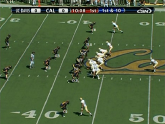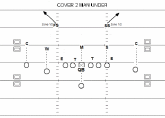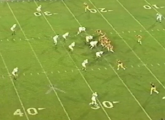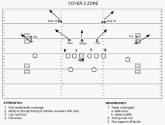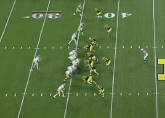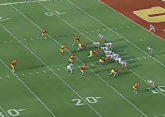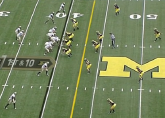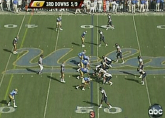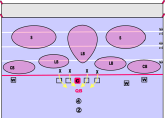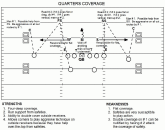Cover zero is a man to man defense where the middle of the field is open and without any deep safety coverage. It is used to take away the run, pressure the quarterback, and deny short passes with most defenders on or near the line of scrimmage threatening to blitz. The middle of the field is open with the free safety rolling up close to the line to cover or blitz. Corners play 3 to 5 yards head up or on the inside shoulder of receivers and often play bump and run coverage. The outside linebackers and safeties take the slots, backs, and tightends. The middle linebacker usually blitzes but other players can be sent. Defenders often look at receivers, rather than at the quarterback.
In cover zero, the seams are in the middle of the field and away from slower defenders since there is no deep safety. QBs can pick up the blitz and get the ball early to an outlet receiver or running back. There is also a curl or post seam in the middle of the field since often the middle linebacker blitzes and there is no safety help. Another option is to throw slants, arrows, outs, ins, digs, drags, posts, corners, and fades to receivers running crossing routes away from the defenders, especially where there are mismatches with faster receivers. Keep in mind that the free safety may disguise cover zero as cover one by setting up deep and then rotating up close to the line of scrimmage.
In cover zero, the seams are in the middle of the field and away from slower defenders since there is no deep safety. QBs can pick up the blitz and get the ball early to an outlet receiver or running back. There is also a curl or post seam in the middle of the field since often the middle linebacker blitzes and there is no safety help. Another option is to throw slants, arrows, outs, ins, digs, drags, posts, corners, and fades to receivers running crossing routes away from the defenders, especially where there are mismatches with faster receivers. Keep in mind that the free safety may disguise cover zero as cover one by setting up deep and then rotating up close to the line of scrimmage.
Cover one is a man to man defense where the middle of the field is closed with only one deep free safety. It is used to take away the run, pressure the quarterback, and disrupt shorter passes with most defenders loading up the box. The middle of the field is closed with the free safety providing deep coverage on a dominant receiver or the play side of the field. Corners play 3 to 5 yards head up or on the inside shoulder of receivers and frequently play bump and run coverage. The outside linebackers and strong safety cover the slots, backs, and tightends. The middle linebacker usually blitzes but other players can too. Defenders often look at receivers rather than at the quarterback.
In cover one, the seams are in the middle curl zones and away from slower defenders. QBs need to pick up the blitz and get the ball early to an outlet receiver or running back. There is also a curl seam in the middle of the field since the middle linebacker often vacates to blitz. Another strategy is to throw slants, arrows, outs, ins, drags, posts, corners, and fades to receivers running crossing routes away from defenders. This is particularly effective where there are mismatches with faster receivers getting open away from the safety. Keep in mind that the free safety may disguise cover one as cover zero by setting up near the scrimmage line and then rolling back to the deep middle.
In cover one, the seams are in the middle curl zones and away from slower defenders. QBs need to pick up the blitz and get the ball early to an outlet receiver or running back. There is also a curl seam in the middle of the field since the middle linebacker often vacates to blitz. Another strategy is to throw slants, arrows, outs, ins, drags, posts, corners, and fades to receivers running crossing routes away from defenders. This is particularly effective where there are mismatches with faster receivers getting open away from the safety. Keep in mind that the free safety may disguise cover one as cover zero by setting up near the scrimmage line and then rolling back to the deep middle.
Cover two can also be a man defense where the middle of the field is open with two deep safeties and five underneath defenders playing man. It is used to take away short passes and offer safety support on long passes. The middle of the field is open with two safeties providing deep coverage by splitting the deepest part of the field into halves. The corners and three linebackers play man coverage on the five eligible receivers. Corners play 3 to 5 yards head up or on the inside shoulder of receivers and often play bump and run coverage. The middle and two outside linebackers cover the slots, backs, and tightends. Defenders often look at receivers rather than at the quarterback.
In cover two man, the seams are away from slower defenders and under or between the two deep safeties. QBs need to throw quick fades, wheels, and corners to receivers running crossing routes away from defenders, especially where there are mismatches with faster receivers. Other options are to run underneath rub routes (slants, arrows, ins, outs, digs, and drags) and then hit the open receiver. This is particularly useful where there are crossing routes run by faster receivers getting open under, between, or away from the safeties. Keep in mind that the corners can disguise cover two man as cover two zone by setting up in the flats and then rolling up to the line of scrimmage.
In cover two man, the seams are away from slower defenders and under or between the two deep safeties. QBs need to throw quick fades, wheels, and corners to receivers running crossing routes away from defenders, especially where there are mismatches with faster receivers. Other options are to run underneath rub routes (slants, arrows, ins, outs, digs, and drags) and then hit the open receiver. This is particularly useful where there are crossing routes run by faster receivers getting open under, between, or away from the safeties. Keep in mind that the corners can disguise cover two man as cover two zone by setting up in the flats and then rolling up to the line of scrimmage.
Cover three is a zone defense where the middle of the field is closed with three deep safeties and four underneath coverage zones. It is used to slow down the running game and prevent the long pass but permit short passes by keeping everything in front of the defense. The middle of the field is closed with the free safety and corners providing deep coverage by dividing the deepest part of the field into thirds. Corners play 7 to 9 yards head up or on the outside shoulder of receivers and retreat to the deep thirds. The outside linebackers take the flats and inside linebackers play the hook to curl zones. Defenders often look at the eyes of the quarterback, rather than at receivers.
In cover three, the seams are in the flats and between the underneath zones. QBs can throw outs, arrows, or screens into the flats and hitches, slants or curls between the linebackers. Other seams are under the linebackers with drags or under the safeties with digs, comebacks, and deep outs. A weakside post seam may also emerge when the free safety cheats to the strong side. A final option is to run four vertical routes or flood one side of the field and stretch key defenders with high-low routes (fade, post, and dig) and then hit the open receiver. Keep in mind that the two corners may disguise cover three as cover one by setting up on a receiver and then rolling back into coverage.
A variation of cover three is Tampa 2 with four underneath zones and three deep zones with the middle linebacker becoming a deep defender. It starts out looking like cover two with two safeties but the middle linebacker drops into the deep middle third of the field. Corners drop into the flats and outside linebackers take the middle underneath zones. Tampa 2 makes the deep pass harder but opens up seams in the flats and hook to curl zones. QBs can throw outs, arrows, or screens to the flats and hitches, slants, or curls between the underneath defenders. Other useful routes are drags under the linebackers, deep outs or comebacks over the corners and digs under the safeties.
In cover three, the seams are in the flats and between the underneath zones. QBs can throw outs, arrows, or screens into the flats and hitches, slants or curls between the linebackers. Other seams are under the linebackers with drags or under the safeties with digs, comebacks, and deep outs. A weakside post seam may also emerge when the free safety cheats to the strong side. A final option is to run four vertical routes or flood one side of the field and stretch key defenders with high-low routes (fade, post, and dig) and then hit the open receiver. Keep in mind that the two corners may disguise cover three as cover one by setting up on a receiver and then rolling back into coverage.
A variation of cover three is Tampa 2 with four underneath zones and three deep zones with the middle linebacker becoming a deep defender. It starts out looking like cover two with two safeties but the middle linebacker drops into the deep middle third of the field. Corners drop into the flats and outside linebackers take the middle underneath zones. Tampa 2 makes the deep pass harder but opens up seams in the flats and hook to curl zones. QBs can throw outs, arrows, or screens to the flats and hitches, slants, or curls between the underneath defenders. Other useful routes are drags under the linebackers, deep outs or comebacks over the corners and digs under the safeties.
Cover four is a zone defense where the middle of the field is open with four deep safeties and only three underneath coverage zones. It is used to prevent long passes and stop the big play but allow shorter passes by keeping everything in front of the defense. The middle of the field is open with the two safeties and corners providing deep coverage by dividing the deepest part of the field into fourths. Corners play 7 to 9 yards head up or on the outside shoulder of the receivers and retreat into their quarter zones. The outside linebackers take the flats and middle linebacker plays the hook to curl zones. Defenders often look at the eyes of the quarterback, rather than at receivers.
In cover four, the seams are in the flats and between the underneath zones. QBs can throw outs, arrows, or screens to the flats and hitches, slants, or curls between the linebackers. Other seams are under the linebackers with drags or under the safeties with digs, deep outs, and comebacks. A quick post, corner, wheel, or fade can be run provided the ball is thrown on a line under the deep defenders. A final strategy is to flood one side of the field and stretch key defenders with high-low routes (post, corner, and deep out) and then hit the open receiver. Keep in mind that the corners may disguise cover four as cover two by setting up in the flats and then rolling back into coverage.
In cover four, the seams are in the flats and between the underneath zones. QBs can throw outs, arrows, or screens to the flats and hitches, slants, or curls between the linebackers. Other seams are under the linebackers with drags or under the safeties with digs, deep outs, and comebacks. A quick post, corner, wheel, or fade can be run provided the ball is thrown on a line under the deep defenders. A final strategy is to flood one side of the field and stretch key defenders with high-low routes (post, corner, and deep out) and then hit the open receiver. Keep in mind that the corners may disguise cover four as cover two by setting up in the flats and then rolling back into coverage.
Cover Zero-Man Coverage with No Deep Safety
Cover One-Man Coverage with 1 Deep Safety
Cover Two-Man Coverage with 2 Deep Safeties
Cover Three-Zone Coverage with 3 Deep Safeties
Cover Four-Zone Coverage with 4 Deep Safeties
Defensive Coverages:
The Straughan’s Air It Out Football Academy offers high caliber instruction on how to recognize and attack defensive coverages. It is simply not enough for quarterbacks to properly throw and receivers to properly catch the football. They also must know how to read and react to defensive coverages. Receivers must be able to run their routes into the open zones and quarterbacks must be able to throw the fooball to the open receiver. Coverage recognition is absolutely essential for quarterbacks and receivers who want to elevate their game performance to compete on the field.
AIOFA teaches the basic strengths and weaknesses of each defensive coverage, including Cover 0, 1, 2, 3, 4 and their many variations. Quarterbacks and receivers are shown how to read and attack coverages by focusing on key guidelines. Some of these include (a) how many defensive backs are deep, (b) whether the middle of the field is open or closed with a free safety, and (c) the leverage, alignment, eyes, and drops of the corners, safeties, and linebackers. Quarterbacks and receivers are also taught how to pick up and adjust to blitzes. See below for an overview of each coverage.
AIOFA teaches the basic strengths and weaknesses of each defensive coverage, including Cover 0, 1, 2, 3, 4 and their many variations. Quarterbacks and receivers are shown how to read and attack coverages by focusing on key guidelines. Some of these include (a) how many defensive backs are deep, (b) whether the middle of the field is open or closed with a free safety, and (c) the leverage, alignment, eyes, and drops of the corners, safeties, and linebackers. Quarterbacks and receivers are also taught how to pick up and adjust to blitzes. See below for an overview of each coverage.
Straughan's Air It Out Football Academy
Director Gene Straughan, PO Box 189, Colton, Washington, 99113, airitoutfootball@yahoo.com, 509-432-5535
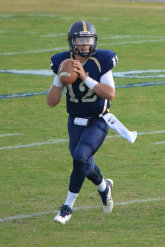
Cover two often is a zone defense where the middle of the field is open with two deep safeties and five underneath coverage zones. It is used to take away the short pass, protect against the long pass, and limit the running game to short yardage. The middle of the field is open with the free safety and the strong safety providing deep coverage by dividing the deepest part of the field into halves. Corners play 3 to 5 yards head up or on the outside shoulder of receivers and drop in the flats. The middle linebacker and two outside linebackers divide the hook to curl zones into thirds for their coverage. Defenders often look at the eyes of the quarterback, rather than at receivers.
In cover two zone, the seams are over the corners and under or between the two safeties. QBs can throw over the corners to receivers running fades, corners, wheels, and comebacks. Other seams are under the safeties with digs, between the safeties with posts, and between the corners and linebackers with shorter routes. Four receivers can streak to stretch the field vertically and create deep open seams. A final option is to flood a side of the field and stretch key defenders with route combinations (post, corner, and deep out) and then hit the open receiver. Keep in mind that the corners may disguise cover two as cover four by setting up deep and then rolling up into the flats.
In cover two zone, the seams are over the corners and under or between the two safeties. QBs can throw over the corners to receivers running fades, corners, wheels, and comebacks. Other seams are under the safeties with digs, between the safeties with posts, and between the corners and linebackers with shorter routes. Four receivers can streak to stretch the field vertically and create deep open seams. A final option is to flood a side of the field and stretch key defenders with route combinations (post, corner, and deep out) and then hit the open receiver. Keep in mind that the corners may disguise cover two as cover four by setting up deep and then rolling up into the flats.
Cover Two-Zone Coverage with 2 Deep Safeties
